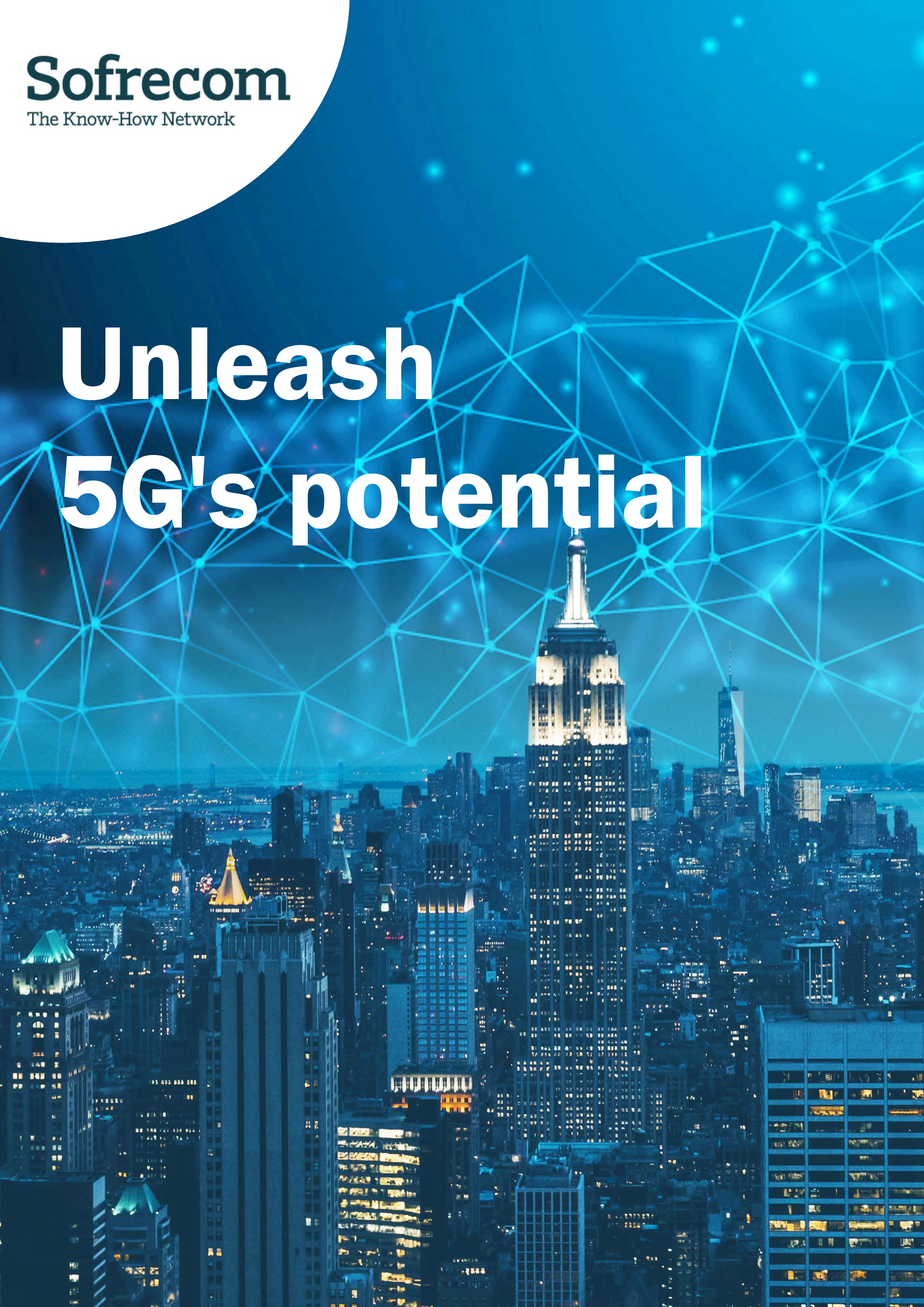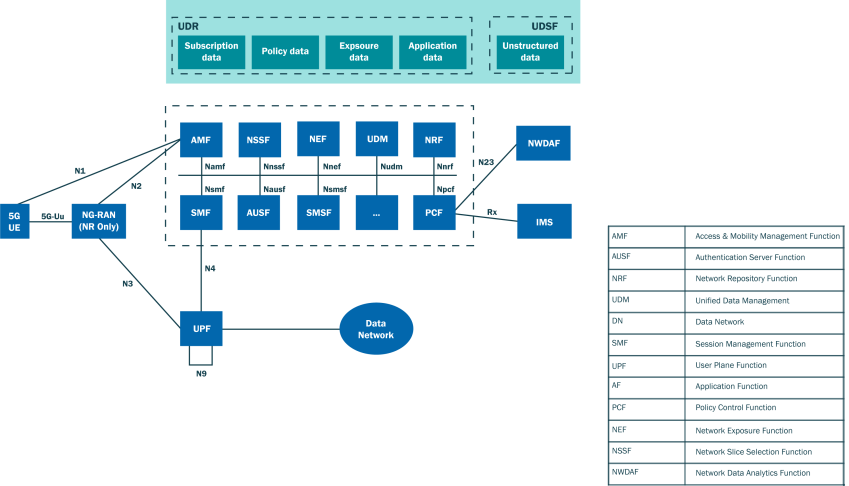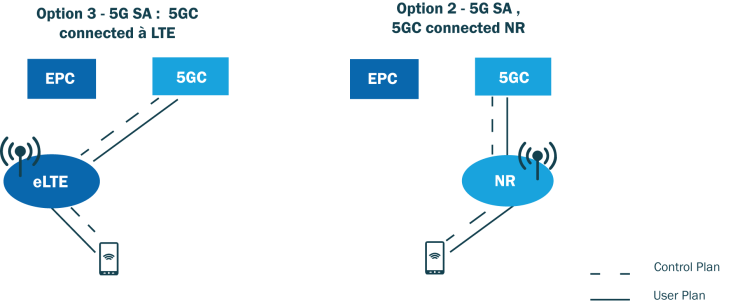With the 5G SA - 5GC the operator takes full advantage of the enhanced mobile broadband (eMBB) of 5G, ultra-reliable low latency (URLLC) communications, and massive machine-like communications (mMTC) capabilities.

If 5G promises to revolutionize many fields, yet it is to release all its hoped-for potential. To introduce this technology to the market quicker, many operators have chosen to deploy it with a 5G NSA (Non standalone). However, this approach limits the implementation of new technological promises: speed, latency, security, slicing, …
The core of a 5G mobile network, called 5GC (5G Core) completely changes its organization and opens important challenges in terms of deployment strategy. As for the virtualization of network functions (NFV), it promises both structural and organizational transformation between operators and integrators.
The specific features of 5GC mobile network core
A mobile network consists of 3 elements: the radio access network, the core network, that allows to route the calls to the destination, the information systems that manage network operations and customer management (invoices, subscriptions, etc.).
The core manages several functions: the accesses and their security management, the subscribers’ authentication, the routing of calls, the management of subscriber services, the control of the communication throughout the duration of the call particularly during the movements of users, the quality of service.
The distinctive feature of the 5G network core (5GC) is its advanced virtualization that allows to separate the software applications of telecommunications from the hardware infrastructures hosting them. Thus, the network can evolve and adapt.
The 5G Core Architecture presents functional similarities with the EPC (Evolved Packet Core) architecture of 4G network. The main evolution consists in the division of network functions (Network Function: NF) in an agile environment.
Among the new functions of this architecture are:
- The NRF (Network Repository Function) catalogue function which acts as a centralized source of information, helping to simplify network management, improve network visibility and support the dynamic deployment of new services and applications.
- The NEF (Network Exposure Function) service exposure feature, which provides different mobile function discovery service, and a service registration management, and a discovery mechanisms service.

Figure 1: 5GC Architecture (source GSMA,5G report implementation guidelines, June 2020)
The main new concepts of 5G Core networks
5G Orchestration is a process for controlling and managing 5G resources both on the radio access (NR) side and on the transport side. In a 5GC network, orchestration is responsible for the coordination of network resources: bandwidth, power, and spectrum. 5GC Orchestration also includes functions such as Service Management, Security Management and Network Delineation. It enables the efficient and effective delivery of 5G services to users too.
An example: a group of connected cars could use orchestration to create a network slice specifically for connected cars, which would constitute a dedicated network with adapted specific characteristics (low latency, high bandwidth). The orchestration system would then manage the allocation of network resources (radio access points, transportation network) to ensure that the network slice meets the required Service Level Agreements (SLAs).
The architecture based on services (SBA) defines a set of services, each with its own interface that can be combined as needed (add or delete a service as needed) which gives it flexibility.
From a functional point of view, the 5GC architecture can be divided into three main parts:
- The control plan is used to manage network signaling and control,
- The user plan manages the transfer of useful data into the network,
- The service plan allows for the creation of new services and features
It is also possible to separate the control and user functions, which facilitates the creation of new services, and the optimization of existing services.
The 3GPP standard introduced stateless architecture for better network optimization and high degree of reliability and resilience. In this network design, the network functions do not retain any status information for individual sessions and instead rely on information from the control plan to make decisions. This enables faster processing and scalability, reduced network latency and improved reliability.
The network slicing is the ability of a 5G network to divide or to allow the network to be broken down into several virtual networks, each having its own resources and characteristics. These logical networks are called slices and can be adapted to the specific needs of each use case. For example, a network slice for autonomous vehicle use will have high performance, safety and reliability requirements compared to a slice for consumer mobile high bandwidth. Another slice network can be created for critical communications with very low latency and high reliability. The slicing can support many services.
Transition to 5 SA architecture with 5G network core
An architecture deployed in NSA 5G mode combines 4G radio access (LTE) and 5G NR (New Radio) radio access controlled by a 4G EPC (Evolved Packet Core) core network. A 5G SA mode network is separate from the 4G network and consists of 5G NR radio access and a 5GC core network. The new 5G antennas (gNodeB) will land at the core of the EPC or 5GC network depending on the NSA/SA mode chosen.
The 3GPP standards (3rd Generation Partnership Project) define 2 options for 5G SA deployment
- Option 5: 5G SA- 5GC connected to LTE: the 5GC core network is deployed but continues to use a 4G LTE access network updated. Most of the new 5G services require NR access, so this option seems unlikely.
- Option 2: 5G SA- 5GC connected to NR: this full 5G SA configuration allows operators to reach the full potential of 5G NR. This scenario is suitable for areas where there is no 4G network.

A progressive and incremental transformation
The migration from 5G NSA to 5G SA requires upgrading or replacing the existing network infrastructure, as well as introducing new software features and protocols to the network. Sometimes complex and time-consuming, this migration is nevertheless an opportunity to introduce new services on a more efficient and secure 5G network.
The migration from EPC (Evolved Packet Core) to 5GC (5G Core) is done in a progressive way by introducing the functionality of 5GC while maintaining existing EPC services. Most operators that have deployed their 5G network have done so with a 5G NSA architecture consisting of a new 5G RAN access and an EPC (4G) network core. Some others have already taken the step of the 5G SA by deploying a 5GC network core and have launched 5G services or are in trial phase with their suppliers.
With the 5G SA - 5GC the operator takes full advantage of the enhanced mobile broadband (eMBB) of 5G, ultra-reliable low latency (URLLC) communications, and massive machine-like communications (mMTC) capabilities. Moreover, the network slicing functionality provides the ability to create virtual networks with different features and Services Level Agreements (SLAs) with a high level of availability ensuring the continuity of service for customers.
This transformation is the essential condition to finally offer all the promises of 5G and enable the scaling up of new business models. Throughout the migration process, it is important to ensure that existing EPC-based 4G services are not affected. 5GC is built on a native cloud design to provide an agile, high-performance, scalable solution.




